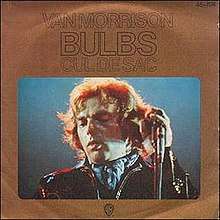Bulbs (song)
"Bulbs" is a song written by Northern Irish singer-songwriter Van Morrison. It was the only single to be taken from his 1974 album Veedon Fleece, with a B-side of "Cul de Sac" for the US release and "Who Was That Masked Man" for the UK release.[1][2]
| "Bulbs" | ||||
|---|---|---|---|---|
 | ||||
| Single by Van Morrison | ||||
| from the album Veedon Fleece | ||||
| A-side | "Bulbs" | |||
| B-side |
| |||
| Released | November 1974 | |||
| Recorded | March 1974, Mercury Studios, New York City, United States | |||
| Genre | Folk rock | |||
| Length | 4:19 | |||
| Label | Warner Bros. | |||
| Songwriter(s) | Van Morrison | |||
| Producer(s) | Van Morrison | |||
| Van Morrison singles chronology | ||||
| ||||
Recording and composition
"Bulbs" was first recorded with different lyrics at the recording session for the 1973 album, Hard Nose the Highway, released in 1973.[3] After the first recording session for Veedon Fleece, "Bulbs" was re-cut at Mercury Studios in New York City in March 1974, along with "Cul de Sac" to give it a more rock feeling. According to Jef Labes this was "cause he (Morrison) didn't feel they had the right feeling... It was me, Van and a bunch of other guys that he'd never played with."[4] Bass player Joe Macho had previously played on the 1966 Bobby Hebb hit song "Sunny".
"Bulbs" has been described as "a pleasant, catchy country ditty, a Dire Straits song before its time" by biographer John Collis.[5] As with many of Morrison's songs, "Bulbs" does not have a clear story line, but in part focuses on immigration to the United States as in the lines:
- She's leaving Pan American
- Suitcase in her hand
- I said her brothers and her sisters
- Are all on Atlantic sand
Critical reception
In an interview with Morrison, Tom Donahue said, after he had listened to "Bulbs": "You always make great noises. The other things you do in songs beside the words."[6]
In a Stylus Magazine review for the album Veedon Fleece, Derek Miller says of the song:[7]
"Of course, the best and most immediately memorable song on Veedon Fleece is "Bulbs". Coming about as close to laying down a groove as he does on the album, the song quickly makes dust of its acoustic start, leaping headstrong into a Waylon Jennings' style bass-roll, rump heavy and plush, pianos shimmering and fingerdense."
Morrison performed the song on the German television show Musikladen on 13 November 1974.[8]
Title
The title might come from the lines:
- And her batteries are corroded
- And her hundred watt bulb just blew
- or the repeated chorus:
- .. she's standing in the shadows
- Where the street lights all turn blue
Personnel
- Van Morrison - vocals
- John Tropea - guitar
- Jef Labes - piano
- Joe Macho - bass
- Allan Schwartzberg- drums
Other releases
A live performance of this song is featured on the 1974 disc of Morrison's 2006 issued DVD, Live at Montreux 1980/1974. Morrison used a stripped-down band on this Montreaux Jazz Festival appearance consisting of:
- Van Morrison - vocals, guitar
- Pete Wingfield - piano, background vocals
- Jerome Rimson - bass, background vocals
- Dallas Taylor - drums
Covers
- Australian blues and root band The Revelators covered the song on their 2000 album, The Adventures of The Amazing Revelators.
- Ellis Hooks performed a cover version of "Bulbs" on the 2003 released tribute album, Vanthology: A Tribute to Van Morrison.[9]
Notes
- "Van Morrison - Bulbs" – via www.45cat.com.
- "Van Morrison - Bulbs" – via www.45cat.com.
- Heylin, Can You Feel the Silence? p. 521
- Heylin, Can You Feel the Silence? p. 284
- Collis, Inarticulate Speech of the Heart, pp. 140–141
- Hinton, Celtic Crossroads, p. 179
- "Van Morrison - Veedon Fleece". stylusmagazine.com. Retrieved 3 August 2008.
- "Lights, Camera, Backbeat - Search". www.lightscamerabackbeat.com.
- Hal Horowitz (5 August 2003). "Vanthology: A Tribute to Van Morrison - Van Morrison | Songs, Reviews, Credits, Awards". AllMusic. Retrieved 15 February 2014.
External links
- lyrics at metrolyrics.com
References
- Collis, John (1996). Inarticulate Speech of the Heart, Little Brown and Company, ISBN 0-306-80811-0
- Heylin, Clinton (2003). Can You Feel the Silence? Van Morrison: A New Biography, Chicago Review Press ISBN 1-55652-542-7
- Hinton, Brian (1997). Celtic Crossroads: The Art of Van Morrison, Sanctuary, ISBN 1-86074-169-X